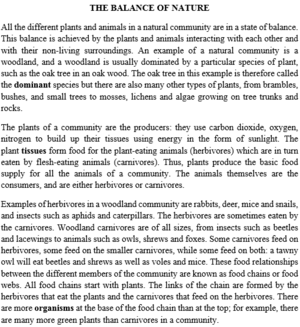Read the following passage and mark the letter A, B, C, or D to indicate the correct answer to each of the questions.


The word "tissues" in paragraph 2 can be best replaced by ____.
Hãy nhập câu hỏi của bạn vào đây, nếu là tài khoản VIP, bạn sẽ được ưu tiên trả lời.

Đáp án: C
Giải thích: obscurity: the state in which sb/sth is not well known or has been forgotten (trạng thái bị lãng quên/không nổi tiếng) = disappearance: sự biến mất.

Question 1. The word "fashion" in line 2 is closest in meaning to____________.
A. maintain B. organize C. trade D. create
Question 2. The Pomo people used each of the following materials to decorate baskets EXCEPT_________.
A. shells B. feathers C. leaves D. bark
Question 3. What is the author's main point in the second paragraph?
A. The neighbors of the Pomo people tried to improve on the Pomo basket weaving techniques.
B. The Pomo people were the most skilled basket weavers in their region.
C. The Pomo people learned their basket weaving techniques from other Native Americans.
D. The Pomo baskets have been handed down for generations.
Question 4. According to the passage, a weft is a____________.
A. tool for separating sedge root B. process used for coloring baskets
C. pliable material woven around the warp D. pattern used to decorate baskets
Question 5. According to the passage, what did the Pomo people use as the warp in their baskets?
A. bulrush B. willow C. sedge D. redbud
Question 6. The word "staples" in line 21 is closest in meaning to____________.
A. combinations B. limitations C. accessories D. basic elements
Question 7. Which of the following statements about Pomo baskets can be best inferred from the passage?
A. Baskets produced by other Native Americans were less varied in design than those of the Pomo people.
B. Baskets produced by Pomo weavers were primarily for ceremonial purposes.
C. There were a very limited number of basket-making materials available to the Pomo people.
D. The basket-making production of the Pomo people has increased over the years.

The Old Man and the Sea is a short novel written by the American author Ernest Hemingway in 1951 in Bimini, Bahamas, and published in 1952. It was the last major work of fiction by Heming way that was published during his lifetime. One of his most famous works, it tells the story of Santiago, an aging Cuban fisherman who struggles with a giant marlin far out in the Gulf Stream off the coast of Floria.
In 1953, The Old Man and the Sea was awarded the Pulitzer Prize for Fiction ,and it was cited by the Nobel Committee as contributing to their awarding of the Nobel Prize in Literature to Hemingway in 1954.
1. Where was Emest Hemingway from?
A. Bahamas B. Cuba C. America D. Spain
2. When was The Old Man and the Sea published?
A. 1951 B. 1952 C. 1953 D. 1954
3. What genre does The Old Man and the Sea belong to?
A. fiction B. comedy C. literature D. romance
4. What does “it” refer?
A. the Pulitzer Prize
B. The Old Man and the Sea
C. the Nobel Committee
D. the coast of Floria
1. Where was Emest Hemingway from?
A. Bahamas B. Cuba C. America D. Spain
2. When was The Old Man and the Sea published?
A. 1951 B. 1952 C. 1953 D. 1954
3. What genre does The Old Man and the Sea belong to?
A. fiction B. comedy C. literature D. romance
4. What does “it” refer?
A. the Pulitzer Prize
B. The Old Man and the Sea
C. the Nobel Committee
D. the coast of Floria

Đáp án: B
Giải thích: Muốn làm được các câu hỏi dạng này phải đọc câu đằng trước các em nhé.

Đáp án A.
Key words: they, last paragraph, refers.
Clue: “Many musicians today credit earlier musicians such as Scott Joplin or Bessie Smith with inspiring their music. It’s a shame that they can’t also name the earliest African-Americans who really began the traditions that led to the American music of today”: Nhiều nhạc sĩ ngày nay ghi nhận những cái tên đi trước như Scott Joplin hay Bessie Smith vì những nghệ sĩ này đã truyền cảm hứng sáng tác cho họ. Đáng tiếc là họ không thể biết được tên tuổi của những người Mĩ gốc Phi xa xưa – những người đã thật sự tạo ra những truyền thống bắt nguồn cho nền âm nhạc nước Mĩ ngày nay.
Đáp án đúng là A. today’s musicians. “Họ” ở đây là những nhạc sĩ ngày nay.
Đáp án: C